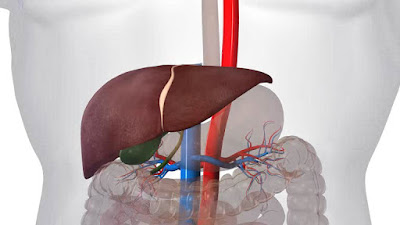What is hemochromatosis?
In hemochromatosis (iron overload) there is too much iron in the body. This iron is stored in the liver and in other organs.
There are two forms of hemochromatosis:
- Primary hemochromatosis is hereditary. The inheritance is recessive. In this disease include the intestines from the birth, too much iron from the diet. This disease is quite common: approximately 1 in 400 people have it.
- Secondary hemochromatosis is the result of another disease. For example, it is caused by chronic anemia or many blood transfusions (eg thalassemia). This form of hemochromatosis is less common.
The symptoms of hemochromatosis in the beginning are always vague. What signs and symptoms can you get?
- A weak and tired feeling.
- Discoloration of the skin.
- Pain in the joints.
- Diabetes mellitus.
- Hair loss.
- Decreased interest in sex.
- Attacks of acute pain in the upper abdomen.
Primary hemochromatosis is treated with phlebotomy (draining blood). People with secondary hemochromatosis given drugs that remove iron from their bodies.
What are the signs and symptoms of hemochromatosis?
Most people get with hemochromatosis only after their fortieth complaints. The first symptoms are vague. They can also be the result of other diseases.
You feel you are becoming weaker and are often very tired. What symptoms you can get even more?
- Discoloration of the skin. Due to the large amount of iron in your body gets your skin a bronze-like color;
- An enlarged liver. In most people, swells in the liver by the iron that is stored in it. The liver can cause severe damage. In severe damage liver cirrhosis or liver cancer can arise.
- Aching joints, especially in the hands and wrists.
- Diabetes (diabetes). This is due to iron overload in the pancreas.
- Or less lost interest in sex and impotence. By iron accumulation in the genitals and the brains, the creation of (sex) hormones are disturbed;
- infertility;
- Hair loss.
- Attacks of acute upper abdominal pain. The cause of this pain is still unknown.
- Heart problems. You will for example shortness of breath with exertion or arrhythmias. These symptoms caused by iron overload in the heart muscle.
- Blistering the skin by sunlight. This is a very rare phenomenon in people with hemochromatosis disease.
How does the doctor determines that you have hemochromatosis?
Tell the doctor that you have hemochromatosis, then they can do different studies:
Blood tests
- The doctor checks if you have anemia. When you have anemia because secondary hemochromatosis.
- The doctor measures the amount of iron and iron transport protein (transferrin) in your blood to see if iron is stacked.
- The doctor also measures the amount of ferritin. This is a protein that provides for the storage of excess iron in the body cells. The more iron there is in the body, the more ferritin is made there. Lots of ferritin in the blood may point to iron overload.
It is well known which gene is usually the cause of primary hemochromatosis. Therefore the disease in many patients could be definitively established by DNA testing. But sometimes it is the exception to another (as yet unknown) gene. Then there are other examinations.
When the doctor has discovered that you have the disease, then it is likely that family members have the disease. It is important that they be quickly informed. For by early treatment many complaints can be prevented.
What is the treatment for hemochromatosis?
Primary hemochromatosis
People with primary hemochromatosis being treated with phlebotomy (draining blood). As a result, the amount of iron in the blood decreases. The body naturally makes new blood. This also is iron used. Per loss disappears about 200 to 250 milligrams of iron from the body. In this way, all of the excess iron from the body can be removed. That could take several years.
Treatment usually starts with one loss each week. Most people have no side effects. Are you getting complaints? For example if you really tired? Then you get a little less frequently a loss.
Once all the excess iron out of your body, you probably need only a couple of losses annually. You must maintain your whole life this treatment.
Tolerate anyone no losses? For example, because he has a very bad heart? Or because blood samples hardly going? Then he can get drugs that remove iron from the body (iron chelators). The best-known drug is Desferal. However, these drugs are less effective than bloodletting and have unpleasant side effects.
Secondary hemochromatosis
People with secondary hemochromatosis often have anemia. This makes bloodletting for them no good treatment. They need to take medications. They can administer the medication through a (portable) infusion pump.
Precepts at primary hemochromatosis
If you have hemochromatosis, you have to follow a strict diet. This fact has little effect. But still want to do something? Drink example tea during meals. Tea sees to it that the iron is absorbed less well.
There are two main precepts:
- Do not drink too much alcohol. Too much alcohol damages the liver, causing liver may incur additional damage. If your iron level is good again and you only need a couple of times a loss per year, but you can occasionally drink a glass of alcohol.
- Do not take too much vitamin C. Vitamin C ensures that iron is better absorbed. A large amount of vitamin C can therefore cause severe symptoms. So do not take pills or drinks with added vitamin C.


